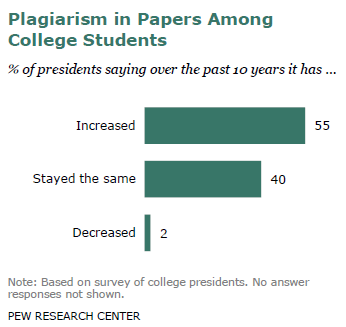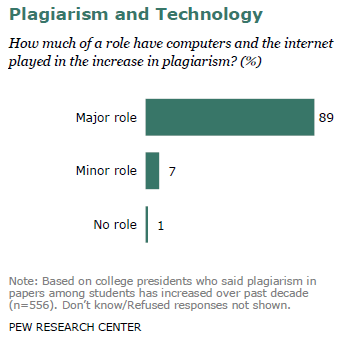Internet Plagiarism and The Turn to Turnitin.com
Few college students graduate without having heard dire warnings about the “sin of plagiarism” (Kennicott, 2002) and what Kim Walden and Alan Peacock (2008) have described as “a pattern of transgressive behaviors, relative to other patterns that are conforming” (p. 134). The dominant narrative of plagiarism in the U.S. is one that collapses a convoluted, culturally situated and constantly negotiated issue into a simplistic discussion that equates plagiarism with notions of sin and transgression. However, plagiarism as sin and transgression is an approach that more closely aligns with the historical etymology of plagiarism—as literary theft and as literal kidnapping—than with the complex landscape of twenty-first century composing. Figure 1 shows the Oxford English Dictionary's historical etymology of plagiarism that equates plagiarism with kidnapping.
 [Figure 1: The Oxford English Dictionary's definition of plagiary]
[Figure 1: The Oxford English Dictionary's definition of plagiary]
That is, plagiarism is not a simple black-and-white ethical or even moral issue; instead, it is a constantly shifting set of concepts and attitudes that represent dominant views of authorship, collaboration, citation, and ownership, among others. Where plagiarism is said to exist, it exists within a system of appropriate and inappropriate behaviors and edicts, both spoken and unspoken, yet that system is not static; for, as Trimbur (1991) described, attitudes toward literacy (and toward plagiarism) move in sync with power and are continually negotiated within hegemonic cultural structures (p. 295). Within such structures, as Walden and Peacock's (2008) quote above reminds us, purportedly transgressive behaviors such as plagiarism only have meaning as they are contrasted against other behaviors that conform and are deemed appropriate. Similarly, within such structures, groups are pitted against each other—student versus teacher, author versus plagiarist, original works versus remixed and adapted ones—often without careful attention to the ways power is circulated within these often-overlapping groups.
Thus the excellent work within our field that has helped us complicate notions of plagiarism does not necessarily echo dominant narratives in the U.S., most of which portray the past two decades as a time of crisis in higher education where cheating has run rampant and Internet plagiarism has steadily risen since the inception of the Web. While much ado has been made about incidents of plagiarism rising in the Internet age, such claims are not only difficult, but unnecessary, to prove. Indeed, some research has indicated that individuals are divided as to whether or not plagiarism itself is on the rise in a networked age. 
For example, a 2011 Pew Internet study of 1,500 college presidents found that 55% of those surveyed felt that the Internet had increased incidents of plagiarism over the past decade while 40% felt that incidents had stayed the same over the past ten years (see image to the right). However, the image below shows that those who believed plagiarism had intensified overwhelmingly attributed that increase to technology (89%).
It is likely that plagiarism is just as common as it was before, but today’s networked technologies afford us the ability to more easily discern plagiarism, particularly cut-and-paste plagiarism (where an author lifts words, phrases, and sentences wholesale and places them in his or her writing with ease). The sheer number of individuals who connected computers and the Internet to a supposed rise in plagiarism shows that many are ready to blame technology, rather than people; many are also likely to turn to technology in the form of plagiarism detection services to solve the problem.
 Along with greater ease in detecting plagiarism, researchers like Sean Zwagerman (2008) have pointed out the cyclical, self-nourishing nature of research on a subject that impacts classroom praxis: Greater attention is being paid to plagiarism; therefore, research on the issue causes greater concern about its presence in the classroom—or as Zwagerman put it, “while plagiarism may or may not be rampant, the belief that it is rampant is certainly rampant” (p. 678).
Along with greater ease in detecting plagiarism, researchers like Sean Zwagerman (2008) have pointed out the cyclical, self-nourishing nature of research on a subject that impacts classroom praxis: Greater attention is being paid to plagiarism; therefore, research on the issue causes greater concern about its presence in the classroom—or as Zwagerman put it, “while plagiarism may or may not be rampant, the belief that it is rampant is certainly rampant” (p. 678).
This kind of self-fulfilling prophecy is evident in the literature of rhetoric and composition; the research we publish and promote often trends along topics of contemporary pedagogical concern. If an issue that can impact the classroom is brought to writing teachers’ attention, then it is likely we will begin to pay more attention to its presence in our teaching. The topics and titles of CCCC presentations, for example, historically show how issues that enter the popular consciousness and filter down to the composition classroom later show up in conference presentations and often, even further down the line, as published research. (See Derek Mueller’s (2012) word cloud analysis of CCCC chairs’ addresses from 1977 to 2011 in Kairos as an example of this kind of topic trending.) Thus the more we believe that Internet plagiarism must be on the rise, the more we may simply accept that as a truism and begin searching for ways to combat the issue, rather than first considering a very important question: Does it matter? After all, if plagiarism has been with us since the time of Martial, who presumably first described plagiarism as literary theft, do we really think we, or any technology, will ever eliminate it completely?
Rebecca Moore Howard (2007), whose work on plagiarism has done much to challenge simple approaches to the issue, has argued that the Internet is undoubtedly changing the nature of authorship today, including making countless texts available for perusal—and, perhaps, plagiarism. She is careful, though, to caution us not to immediately ascribe greater access to greater incidence, so that we do not assume that plagiarism is “like a disease in which the presence of so much readily available text infects writers, lowering their moral resistance and causing them to plagiarize” (p. 5). Other researchers in rhetoric and composition have also pushed us to complicate the seemingly simple term plagiarism. For example, the values and assumptions revealed by discussions of plagiarism depict how much the rules depend on cultural narratives (Donahue, 2008), communal definitions of concepts like common knowledge (England, 2008), organizational standards of efficiency (Anson & Neely, 2011), discourse community (Gerhardt, 2006), and so on. While the dominant narrative regarding plagiarism seems to imply that the issue is simply a matter of citing and using sources appropriately, our field has benefited from the additional layers of complexity offered through terms like Howard's (1993) patchwriting, research from The Citation Project, monographs that historicize and complicate plagiarism like Bill Marsh's (2007) Plagiarism: Alchemy and Remedy in Higher Education, and so on. Much like Trimbur's (1991) note that literacy is often erroneously considered “a neutral technology,” this research reminds us to be careful to not fall into uncomplicated, neutral assumptions about plagiarism and instead struggle to articulate and understand a concept that resists easy understandings.
index ![]()
![]() the specter of internet plagiarism
the specter of internet plagiarism ![]()
![]() the turn to turnitin.com page 1
the turn to turnitin.com page 1 ![]() page 2
page 2 ![]() page 3
page 3 ![]() page 4
page 4 ![]() page 5
page 5 ![]() page 6
page 6 ![]()
![]() authorship and anxiety page 1
authorship and anxiety page 1 ![]() page 2
page 2 ![]() page 3
page 3 ![]() page 4
page 4 ![]() page 5
page 5 ![]() page 6
page 6 ![]()
![]() critical assessment
critical assessment ![]()
![]() references
references

